
Introduction and History
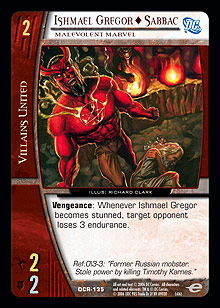 The first two DC Modern Age decks I reviewed were control decks, so it’s about time I go over the most popular archetype for unknown formats: the rush deck. There are plenty of teams that can be built around a rush strategy, including JSA up-curve and Shadowpact blitz, but the team I’m going to look at this week is none other than Villains United. This team has a lot of characters with high ATK values, such as Bizarro, ME AM BIZARRO #1 and Dr. Psycho, Mental Giant, and cards that burn your opponent, like Ishmael Gregor ◊ Sabbac and Deathstroke the Terminator, Lethal Weapon. Rush decks that incorporate burn effects have proven to be very effective in the past because they don’t have to rely on combat alone to win games and have an alternate method of dealing damage. Villains United seems like the perfect team to be built around the rush archetype.
The first two DC Modern Age decks I reviewed were control decks, so it’s about time I go over the most popular archetype for unknown formats: the rush deck. There are plenty of teams that can be built around a rush strategy, including JSA up-curve and Shadowpact blitz, but the team I’m going to look at this week is none other than Villains United. This team has a lot of characters with high ATK values, such as Bizarro, ME AM BIZARRO #1 and Dr. Psycho, Mental Giant, and cards that burn your opponent, like Ishmael Gregor ◊ Sabbac and Deathstroke the Terminator, Lethal Weapon. Rush decks that incorporate burn effects have proven to be very effective in the past because they don’t have to rely on combat alone to win games and have an alternate method of dealing damage. Villains United seems like the perfect team to be built around the rush archetype.
The Villains United team actually made its major event debut as the secondary team in Checkmate / Villains United at Pro Circuit San Francisco. Many players have only been interested in Villains because of The Science Spire, and as a result, any deck including the team that’s put up a major finish has been a team-up deck, such as X-Statix / Villains United or the Villains United toolbox deck that the Australians played at PC: San Francisco. However, mono–Villains United has a lot of potential to be the next Squadron Supreme of the Modern Age format because the team contains many of the tools necessary for a powerful and explosive deck.
The Build
Characters
4 Cheetah, Feral Feline
4 Count Vertigo, Werner Vertigo
4 Dr. Psycho, Mental Giant
4 Ishmael Gregor ◊ Sabbac, Malevolent Marvel
4 Zazzala ◊ Queen Bee, Mistress of the Hive
2 The Calculator, Evil Oracle
4 Deathstroke the Terminator, Lethal Weapon
1 Bizarro, ME AM BIZARRO #1
1 Alexander Luthor, Insidious Impostor
4 Black Adam, Teth-Adam
2 Jay Garrick ◊ The Flash, Golden Age Speedster
Plot Twists
4 Air Strike
4 Blinding Rage
4 Epic Battle
4 Baddest of the Bad
4 Systematic Torture
2 No Mercy
Equipment
4 Laser Watch
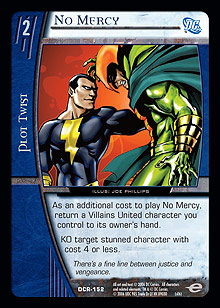 Villains United has something that most other teams in DC Modern Age don’t—a true KO effect. There are certainly plenty of removal effects in this format, like Removed from Continuity and Death Trap, but only Injustice Gang, Checkmate, and Villains United have cards that actually make characters hit the KO’d pile. Ahmed Samsarra’s popularity is extremely beneficial to Villains because they can snag easy wins with No Mercy and Systematic Torture if they get the King stunned. The rest of this build is pretty standard—plenty of characters, pumps, and the only 0-cost “generic” equipment in this format besides Nth Metal and the Fate Artifacts.
Villains United has something that most other teams in DC Modern Age don’t—a true KO effect. There are certainly plenty of removal effects in this format, like Removed from Continuity and Death Trap, but only Injustice Gang, Checkmate, and Villains United have cards that actually make characters hit the KO’d pile. Ahmed Samsarra’s popularity is extremely beneficial to Villains because they can snag easy wins with No Mercy and Systematic Torture if they get the King stunned. The rest of this build is pretty standard—plenty of characters, pumps, and the only 0-cost “generic” equipment in this format besides Nth Metal and the Fate Artifacts.
The Strategy
Villains United is one of the simpler decks you can play in DC Modern Age compared to Good Guys or Checkmate / Villains United. The biggest decision you’ll have to make throughout the entire game is who to attack, and you can blame most of your losses on draws rather than play errors. The initiative you prefer really depends on the matchup, because against some decks you can kill on turn 5 but against others the game will be going too slowly for you to do so. I like to take evens just to be safe, because if you put all your eggs in one basket on turn 5 and can’t finish your opponent off, you’re going to be in big trouble on turn 6. I’ll gladly wait an extra turn to kill my opponent if it means I can do so more reliably. Your mulligan condition is also unclear; generally, you want a hand containing a 2-drop, but there are plenty of exceptions to this rule. You want to mulligan for the low end of your curve, and your opening hand should contain two or more different characters with a cost of 4 or less.
With this deck, you always want to take advantage of swinging up the curve. Swinging up the curve generates board advantage, which eventually translates into endurance advantage around turn 5 or 6. Always use your ATK pumps to help your characters get over your opponent’s defenses rather than to cause breakthrough, unless you think you can make a huge attack that will end the game. Even so, using all of your ATK pumps on the “last” attack of the game can be risky, because if your opponent has any reinforcement tricks or plays Die for Darkseid!, then you’ve just put yourself in a pretty ugly position.
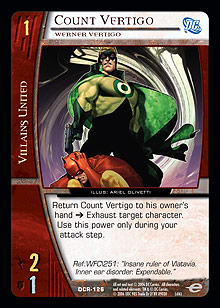 Hitting a 1-drop actually gives you more of an advantage than you might think, but they aren’t entirely necessary here like they are in other formats. Both your 1-drops have 2 ATK, so sometimes they can stun opposing 2-drops without any help. Villains United has a sub-theme of bouncing characters to your hand for extra effects, so by hitting a 1-drop, you have an extra character with which to feed effects like The Calculator, Evil Oracle and Baddest of the Bad. In situations where you need more ATK power, you can suicide Cheetah into one of your opponent’s characters to spread +1 ATK counters across your board. Count Vertigo may seem next to useless in a deck that relies on combat and not exhaustion tricks, but he can actually win you games if he sticks around long enough. When the game is in its final stages, what you can do is attack all of your opponent’s smaller characters to force extra amounts of breakthrough, but leave his or her biggest character untouched. Then, you can bounce Vertigo to your hand to exhaust that character, and your opponent won’t be able to attack back to put you further in the negatives than he or she is.
Hitting a 1-drop actually gives you more of an advantage than you might think, but they aren’t entirely necessary here like they are in other formats. Both your 1-drops have 2 ATK, so sometimes they can stun opposing 2-drops without any help. Villains United has a sub-theme of bouncing characters to your hand for extra effects, so by hitting a 1-drop, you have an extra character with which to feed effects like The Calculator, Evil Oracle and Baddest of the Bad. In situations where you need more ATK power, you can suicide Cheetah into one of your opponent’s characters to spread +1 ATK counters across your board. Count Vertigo may seem next to useless in a deck that relies on combat and not exhaustion tricks, but he can actually win you games if he sticks around long enough. When the game is in its final stages, what you can do is attack all of your opponent’s smaller characters to force extra amounts of breakthrough, but leave his or her biggest character untouched. Then, you can bounce Vertigo to your hand to exhaust that character, and your opponent won’t be able to attack back to put you further in the negatives than he or she is.
Ishmael Gregor ◊ Sabbac is an interesting card. If he had been printed in an older set, he would have been a great character, but now times have changed and many people are very hesitant to play him. 2 ATK / 2 DEF used to be average for a 2-drop, but newer sets have set higher standards, and now it’s considered mediocre. Most 2-drops have 3 DEF, so Sabbac can’t naturally stun them, which can be very problematic in the early stages of the game. However, in theory his vengeance effect should offset this disadvantage, but does it always? Some players would argue that running a 2-drop that can reliably stun opposing characters of the same cost would be better than burning for an average of 6 to 9 endurance over the course of the game, but I think otherwise. The damage that Sabbac’s vengeance effect causes really adds up, and if you equip Laser Watch to him or team attack with him and your 1-drop, then you should rarely fail attacks against other 2-drops. You can also suicide Sabbac into a character, make your opponent lose 3 endurance, and then bounce him back to your hand with The Calculator, Evil Oracle to pump one of your other characters. If you’re really opposed to playing Sabbac, you can always run Talia, Beloved Betrayer as one of your 2-drops, but I think you should at least try him out before you dismiss him as a bad card.
Your other 2-drop, Dr. Psycho, Mental Giant, is a much more conventional card. I think the R&D guys were smart when giving Psycho only 1 DEF, because if 1-drops were unable to stun him, his effect would be just a little too good. This format seems to be filled with 1-drops, and I have yet to see a deck that doesn’t run any. However, you should view Psycho’s vengeance effect as a bonus rather than a necessity. Most opponents will make smart formations that prevent Dr. Psycho from stunning two characters, so if you’re better off swinging into a 1-drop, then don’t worry about it. His 4 ATK will also allow you to stun your opponent’s 4-drops with the help of Blinding Rage, and he can stun some 3-drops naturally.
 On turn 3, you always want to recruit Zazzala ◊ Queen Bee, Mistress of the Hive into the hidden area. Her effect really adds up over the course of the game, and if you keep her concealed, you’ll be able to control whether or not she’s stunned when a character leaves play during the combat phase. Remember to use all of your effects that make characters leave play during the combat phase, such as KO effects or return to hand effects. If you miss Zazzala, The Calculator, Evil Oracle is less optimal but still a decent play. Remember that if you don’t have 1- or 2-drops to bounce for The Calculator’s effect, he can bounce himself back to your hand. It’s unfortunate that Zazzala and The Calculator are both 3-drops, because their effects compliment each other nicely. If you miss your 4-drop and have to under-drop, playing your second 3-drop and a 1-drop is never a bad play.
On turn 3, you always want to recruit Zazzala ◊ Queen Bee, Mistress of the Hive into the hidden area. Her effect really adds up over the course of the game, and if you keep her concealed, you’ll be able to control whether or not she’s stunned when a character leaves play during the combat phase. Remember to use all of your effects that make characters leave play during the combat phase, such as KO effects or return to hand effects. If you miss Zazzala, The Calculator, Evil Oracle is less optimal but still a decent play. Remember that if you don’t have 1- or 2-drops to bounce for The Calculator’s effect, he can bounce himself back to your hand. It’s unfortunate that Zazzala and The Calculator are both 3-drops, because their effects compliment each other nicely. If you miss your 4-drop and have to under-drop, playing your second 3-drop and a 1-drop is never a bad play.
Deathstroke the Terminator, Lethal Weapon is your primary 4-drop because of his burn effect. However, just like Sabbac, he has really weak stats compared to the other 4-drops in this format. You need to save a Laser Watch for Deathstroke to ensure the stun while swinging across the curve, or else you could end up having to waste pumps against a character with 8 DEF. If you’re not a fan of Sabbac, that doesn’t mean you have to dislike Deathstroke as well, because the difference between the two characters is the timing of their recruitment. By turn 4, the game state will be much more open than it was on turn 2, so if Deathstroke can’t stun your opponent’s 4-drop, you still have other options about where to attack. On turn 2, though, the only thing you can really do is swing across at your opponent’s 2-drop. Deathstroke’s stats are less of a disadvantage by the time turn 4 rolls around, so even though he’s mechanically the same as Sabbac, he operates differently because of the environment into which he’s recruited.
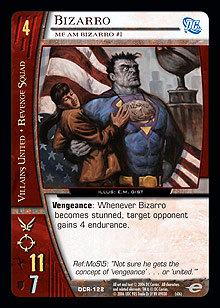 Your alternate 4-drops are intended for decks where simply burning your opponent with Deathstroke isn’t enough. Specifically, if you’re facing a defensive-minded deck, Deathstroke’s meager stats can be a real problem, and instead of relying on burning, you’re better off beating your opponent down with huge characters. Bizarro, ME AM BIZARRO #1 is the perfect manifestation of a beatdown card. I absolutely love the new Bizarro, both in Constructed and Sealed Pack formats, because he’s basically Sabretooth, Feral Rage with flight and range. He can easily stun 5-drops without any help, and the amount of board advantage you can gain with him makes up for his vengeance effect. If your hand is low on ATK pumps and your opponent’s deck looks like it could brickwall you at any time, searching out Bizarro and smashing face is a better option than recruiting Deathstroke on turn 4.
Your alternate 4-drops are intended for decks where simply burning your opponent with Deathstroke isn’t enough. Specifically, if you’re facing a defensive-minded deck, Deathstroke’s meager stats can be a real problem, and instead of relying on burning, you’re better off beating your opponent down with huge characters. Bizarro, ME AM BIZARRO #1 is the perfect manifestation of a beatdown card. I absolutely love the new Bizarro, both in Constructed and Sealed Pack formats, because he’s basically Sabretooth, Feral Rage with flight and range. He can easily stun 5-drops without any help, and the amount of board advantage you can gain with him makes up for his vengeance effect. If your hand is low on ATK pumps and your opponent’s deck looks like it could brickwall you at any time, searching out Bizarro and smashing face is a better option than recruiting Deathstroke on turn 4.
Alexander Luthor, Insidious Impostor is for the Injustice Gang matchup. Should you face a deck that forces you to draw cards, Alexander Luthor will turn all of the characters in your hand into +2 ATK pumps. He’s not exactly a bad character against other decks either, because you’ll always have dead character cards just sitting in your hand that you can pitch for his effect. Drawing a card never hurts either, especially if you draw into an ATK pump that you can use to swing up the curve.
Black Adam, Teth-Adam should always be your turn 5 play. His stats may be nothing special, but 10 ATK and flight is good enough for a 5-drop. Black Adam’s effect is what really makes him good though; it’s easy to get him stunned, and giving a Grand Gesture effect to anyone can either help you cause more damage or prevent one of your characters from stunning while attacking. Turn 5 is where you really have to start considering all your attack options, because at this point, you should be more concerned about finishing the game than generating any more board advantage. Before you make any attacks, make sure you’ve considered all your options, and instead of thinking a single attack through at a time, plan out how the entire combat phase will play out before declaring anything. While defending, unless you’re below 15 endurance, don’t try forming your characters to prevent breakthrough. Counterattacks are more important than saving endurance, so push all your characters without range to the front row even if they’re vulnerable targets.
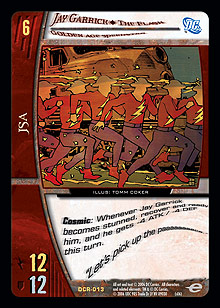 For the big turn 6 play, we have Jay Garrick ◊ The Flash. Some people think this card is just plain random, while others thing he’s simply amazing. I don’t know where I stand, but he definitely deserves more credit than he gets. What I really like about him is that you don’t have to prevent him from stunning to ready him. What’s frustrating about many of the “speedster” cards in this game is that to get the most out of them, you have to make sure they don’t get stunned while attacking, which is usually much harder than it seems. Blinding Rage makes it easy for The Flash to get stunned, and cards like Epic Battle and Air Strike that last for the whole turn combo nicely with him. Assuming your opponent is playing a curve deck, you want to swing The Flash into your opponent’s 6-drop with Blinding Rage, swing Black Adam into your opponent’s 5-drop and shrink his or her 4-drop, and then swing The Flash back at the smaller opposing 4-drop. After that, all your attacks will be elementary and you should be able to bash your opponent well into the negatives. If you haven’t hit a copy of The Flash by turn 6, under-dropping is always an acceptable play. Just make sure that you can end the game with whoever you recruit on turn 6, because if the game goes any longer than that, your chances of victory decrease exponentially.
For the big turn 6 play, we have Jay Garrick ◊ The Flash. Some people think this card is just plain random, while others thing he’s simply amazing. I don’t know where I stand, but he definitely deserves more credit than he gets. What I really like about him is that you don’t have to prevent him from stunning to ready him. What’s frustrating about many of the “speedster” cards in this game is that to get the most out of them, you have to make sure they don’t get stunned while attacking, which is usually much harder than it seems. Blinding Rage makes it easy for The Flash to get stunned, and cards like Epic Battle and Air Strike that last for the whole turn combo nicely with him. Assuming your opponent is playing a curve deck, you want to swing The Flash into your opponent’s 6-drop with Blinding Rage, swing Black Adam into your opponent’s 5-drop and shrink his or her 4-drop, and then swing The Flash back at the smaller opposing 4-drop. After that, all your attacks will be elementary and you should be able to bash your opponent well into the negatives. If you haven’t hit a copy of The Flash by turn 6, under-dropping is always an acceptable play. Just make sure that you can end the game with whoever you recruit on turn 6, because if the game goes any longer than that, your chances of victory decrease exponentially.
Matchups
Good Guys:
This matchup is very difficult because of how easy it is for the Good Guys player to brickwall you on turn 4 with a Shayera ◊ Thal Hawkwoman / Katar Hol ◊ Hawkman, Thanagarian Enforcer loop. For those who don’t know, a Shayera / Katar Hol loop works like this: your opponent powers-up Katar Hol, then uses Shayera’s effect to search for another copy of Katar Hol, then powers-up again, then searches again, and repeats. Most Good Guys decks run five total copies of Katar Hol, so besides the copy in play, they have access to four power-ups. If Booster Gold is in play, those four power-ups total 8 DEF, and while it’s certainly possible to clear that if you have enough pumps, you can’t rely on drawing into that many by turn 4. On top of that, your opponent may be able to negate some of your attack pumps with BWA HA HA HA HA! But, if you manage to stun Katar Hol and KO him, then it’ll all be worth it. So, during the first three turns of the game, try to be conservative and save all your pumps because you’re going to need them against Katar Hol. Team attacking to ensure the stun is never a bad idea either; just make sure you save one character to exhaust for Systematic Torture. After that, your game plan is pretty standard; continue dropping characters and doing damage, and always attack Fire first on turn 5 or 6 so she can only burn you once or twice.
Checkmate / Villains United:
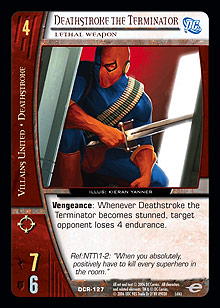 Most Checkmate / Villains United players will be afraid of your KO effects and elect to play Ahmed Samsarra in the hidden area. While this play means it will be hard for you to KO the King, your opponent is also unknowingly giving you an even bigger advantage. If Ahmed is in the hidden area, then you don’t have to attack a 6 ATK / 6 DEF body to get to your opponent’s endurance total. Swinging Deathstroke the Terminator, Lethal Weapon into Bizarro, ME AM BIZARRO #1 is perhaps one of the most amusing attacks you can make in Vs. System because, assuming there are no combat modifiers from either side, you’ll lose 0 endurance and your opponent will lose 8. All of your ATK pumps can easily overcome opposing Checkmate Safe Houses and Knightmare Scenarios, and if you manage to KO the opponent’s 4- or 5-drop, it’s usually game. Mr. Freeze, Brutal Blizzard can be problematic if the game is going to turn 6, especially if you have even initiatives. But there will be times where you can choose to attack him or not, and if you know you have enough firepower to end the game on turn 6, then you should just pass and go to recovery. Your offensive cards are too much for the Checkmate / Villains United player to handle, and if your opponent is careless enough to put Ahmed in the visible area, then you’ll win by King KO.
Most Checkmate / Villains United players will be afraid of your KO effects and elect to play Ahmed Samsarra in the hidden area. While this play means it will be hard for you to KO the King, your opponent is also unknowingly giving you an even bigger advantage. If Ahmed is in the hidden area, then you don’t have to attack a 6 ATK / 6 DEF body to get to your opponent’s endurance total. Swinging Deathstroke the Terminator, Lethal Weapon into Bizarro, ME AM BIZARRO #1 is perhaps one of the most amusing attacks you can make in Vs. System because, assuming there are no combat modifiers from either side, you’ll lose 0 endurance and your opponent will lose 8. All of your ATK pumps can easily overcome opposing Checkmate Safe Houses and Knightmare Scenarios, and if you manage to KO the opponent’s 4- or 5-drop, it’s usually game. Mr. Freeze, Brutal Blizzard can be problematic if the game is going to turn 6, especially if you have even initiatives. But there will be times where you can choose to attack him or not, and if you know you have enough firepower to end the game on turn 6, then you should just pass and go to recovery. Your offensive cards are too much for the Checkmate / Villains United player to handle, and if your opponent is careless enough to put Ahmed in the visible area, then you’ll win by King KO.
Fate Artifacts:
As with every other deck I’ve reviewed so far, the key to winning this matchup is removal effects. Do everything you can to KO your opponent’s suited up character, because once the Artifacts are out of the picture, your opponent’s characters will all be average sized. Try saving at least two KO effects for your opponent’s character, because if your opponent has a Huntress, Reluctant Queen, then he or she can negate one of them. Stick with your normal game plan of swinging up the curve and saving up for one big attack step, and even if your opponent manages to keep the Fate Artifacts in play, you can usually pump over them. The only thing you really have to remember here is that Black Adam’s effect can’t target a character equipped with Cloak of Nabu, so don’t try getting Adam stunned and shrinking your opponent’s equipped character.
Conclusions
Villains United is a strong team with a solid character base and powerful KO effects. An extremely fast strategy exists within practically every format, and Villains United seems to be the most powerful one in DC Modern Age. There are plenty of things that could be changed about the list I provided, such as character ratios or the plot twist selections; most of the cards in this deck come down to personal taste. Return Fire! could be added for extra burn; Alexander Luthor, Diabolical Double could be your 6-drop instead of The Flash; and the deck could even take a more off-curve approach and play No Hope to burn for even more endurance. When Pro Circuit Indianapolis rolls around in just one more week, the Villains United team may make a stand on its own, without the help of a Team-Up card or Checkmate characters.
As usual, questions, comments, suggestions, complaints, and requests to meet up at Indy can be sent to gvl@nc.rr.com.